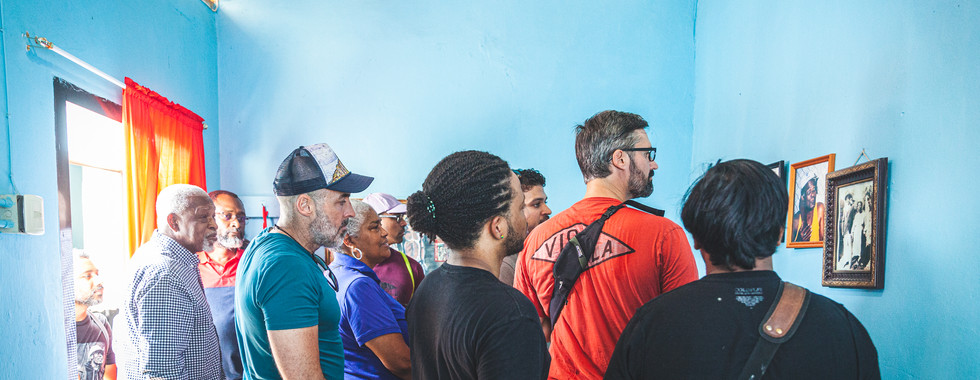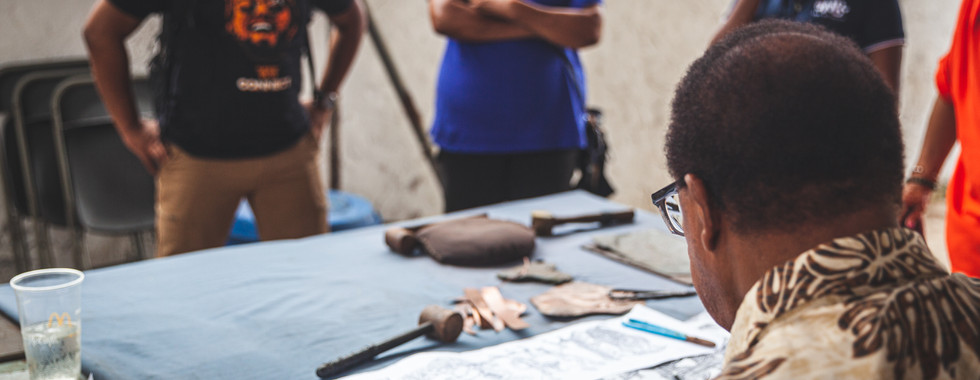Out and About in Belmont, Trinidad
- Ariann Mieka
- 6 days ago
- 4 min read
As part of one of my courses called Dynamics of Caribbean Culture, each student was tasked with designing and hosting an immersive cultural outing. For my tour, I chose Belmont—a community rich in architectural heritage, history, and artisanship.
We started our journey at Mille Fleurs, one of the Magnificent Seven buildings, where we waited for our group to gather. While there, some of us took the opportunity to view a small exhibit on the Spiritual Baptist faith. Once everyone arrived, we piled into a 14-seater maxi and set off on a four-hour cultural adventure through Belmont. And while four hours is hardly enough to take in everything this vibrant district has to offer, what we experienced was meaningful, interactive, and inspiring.
1. Architecture Walk with Rudylynn Roberts
Our journey through Belmont was enriched by the presence of architect and heritage preservationist Rudylynn Roberts. A founding member of Citizens for Conservation, Rudylynn is one of Trinidad and Tobago’s leading voices in preserving built heritage. As we drove and occasionally walked through Belmont, she pointed out significant homes, public buildings, and architectural features.
Belmont boasts the largest concentration of vernacular architecture in a single, easily accessible location in Trinidad. Many of its grander homes were designed or influenced by architect George Brown and reflect a uniquely local style adapted to the Caribbean climate. With fretwork, wide verandas, and louvered windows, these homes were among the region’s earliest “green” houses—designed for ventilation and comfort. I had passed many of these buildings’ countless times before, but this was my first time studying them and learning the stories they held.
2. Rada Compound: Dangbwe Comme
Our first stop was the historic Rada Compound, also known as Dangbwe Comme—the only one of its kind outside Dahomey (present-day Benin) in West Africa. This sacred site has preserved the religion of Vodun for over 150 years. It was founded in 1868 by Abojevi Zahwenu, also known as Robert Antoine or Papa Nanee, a Dahomean soldier who was rescued from enslavement and brought to Trinidad.
We were warmly welcomed by Mr. Henry Antoine, a descendant of the founder, who gave us a guided tour of the compound. He shared the history of their spiritual practices and showed us the chapel, shrines, and other spaces used in religious ceremonies. We viewed photos, artifacts, and altars, and gained a deeper understanding of this living tradition that has endured despite centuries of cultural suppression.
3. Meyler House: The Angelo Bissessarsingh Heritage House
Our next stop was the charming Victorian-era Meyler House, now known as the Angelo Bissessarsingh Heritage House. Built around 1910, this restored residence now serves as a heritage space filled with antiques and memorabilia.
Groups can arrange guided tours of the house and even enjoy refreshments on the back patio. It’s also available for events, workshops, and photoshoots. Walking through the rooms and looking at the antiques and architectural elements felt like stepping back in time. It was a quiet, beautiful pause in the tour where we enjoyed some refreshments.
4. Ken Morris House: Master of Copper Art and Carnival Design
We then visited the former home and workshop of legendary Carnival craftsman and metalworker Ken Morris. A self-taught artist, Morris revolutionized copper work in Trinidad and seamlessly blended fine art with Carnival design. His home—a traditional two-family barrack-style house—includes a shed where he once crafted his pieces.
There we met his son, Glen Morris, who has continued the family tradition. Glen gave us a live demonstration, showing us how different textures are achieved and explaining the techniques of copper shaping. Each of us got to try our hand at the craft—a fun hands-on moment. I could’ve spent all day there, and I would love to return to learn more from Glen.
5. Wire Bending Studio of Richard Lera
Our final stop was the studio of wire bender Richard Lera—a first-time experience for many of us, myself included. Wire bending has been essential to Trinidad and Tobago’s Carnival since the 1930s, forming the framework for everything from backpacks to bras to massive costume structures.
Richard welcomed us into his workshop and shared the history of the craft, explaining how wire bending combines elements of architecture, sculpture, and engineering. Though traditionally done with wire, other materials are also used. The result? Kinetic sculptures that dance through the streets during Carnival, sometimes towering over 20 feet tall. Richard’s stories and skill made it clear: this is not just craft—it’s art.
Back at Mille Fleurs
We returned to Mille Fleurs after our whirlwind tour, our heads full of stories, insights, and inspiration. Belmont had revealed itself not just as a neighborhood, but as a living museum—bursting with creativity, craftsmanship, and deep cultural roots.
And we only scratched the surface. There’s still so much more to discover. So, I’m encouraging you—grab a friend (or two), map out a few stops (these or ones you’re curious about), and take your own walk through Belmont. I’d be happy to share details on the places we visited if you’re interested.
Is there somewhere I have to check out on my next visit? Have you always wanted to try your hand at wire bending or copper work? Let me know—I’m down to plan a workshop! Let’s make it happen.


















































































Comments